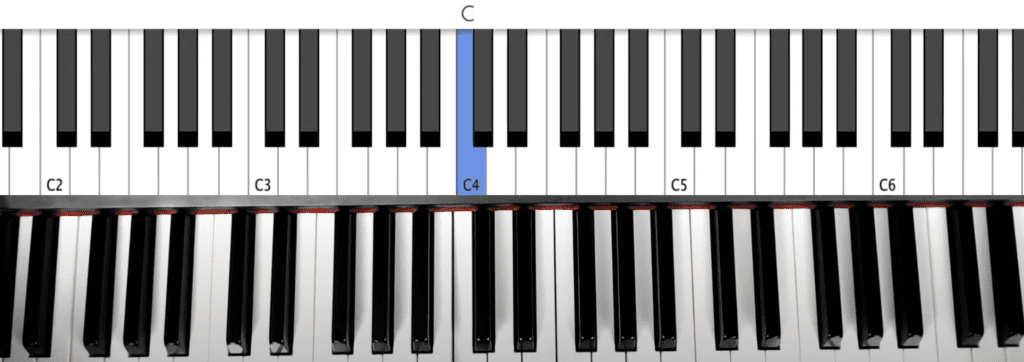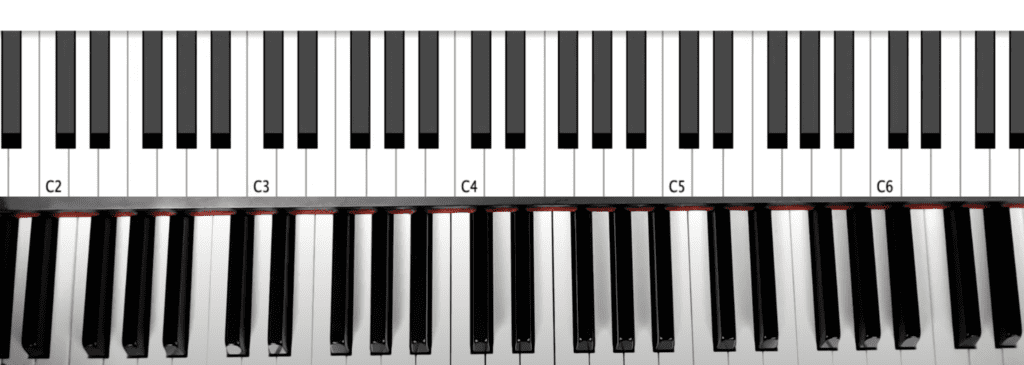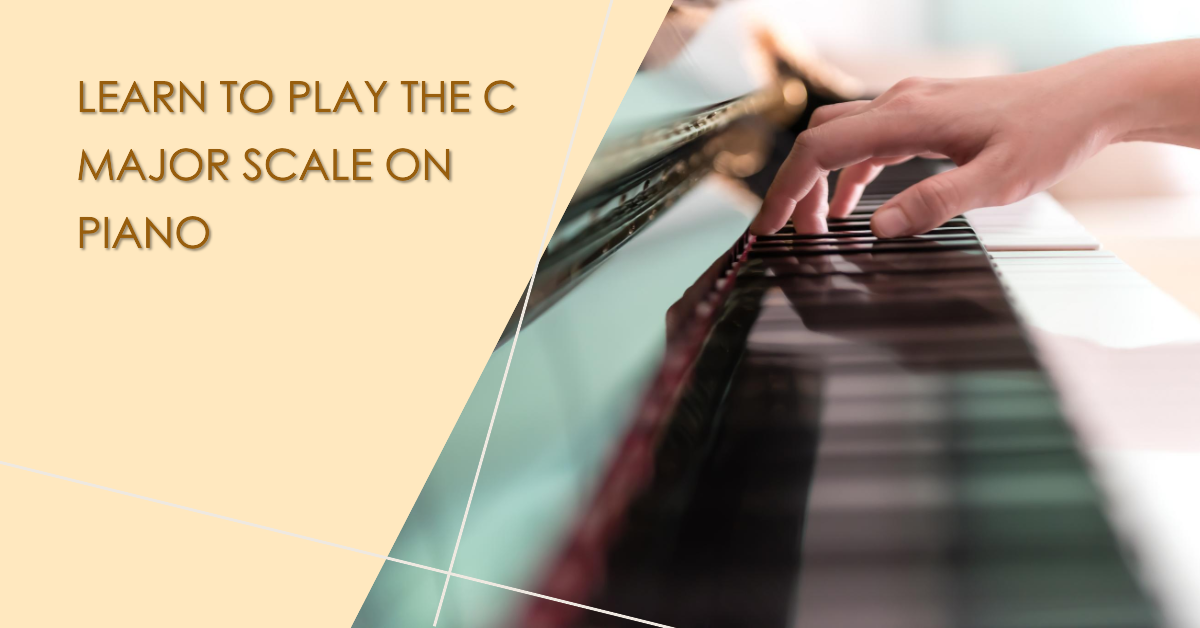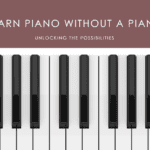Learning how to play the C major scale on piano is one of the first things you’ll learn as a beginner pianist. Having a solid understanding of scales will help you gain finger dexterity, improve your technique, and understand keys and chord progressions. The C major scale is the easiest scale to learn first because it only contains the white keys and no black keys.
In this comprehensive guide, I’ll walk you through step-by-step on how to play a C major scale, explain the theory behind it, and give you tips on how to master it. Let’s get started!
What Is A C Major Scale?
A C major scale is a diatonic scale that only consists of the white keys on the piano. The scale starts on C and goes up to the next C using just the white keys. The C major scale follows the W-W-H-W-W-W-H interval pattern, where W stands for whole step and H stands for half step.
Here are a few key facts about the C major scale:
- It has no sharps or flats.
- The key signature is empty.
- It consists of the notes C, D, E, F, G, A, B, C.
- The half steps are between E & F and B & C.
Understanding these basics about the C major scale will help you recognize it and know how to build it.
Step-By-Step To Play A C Major Scale
Now let’s go through how to actually play a C major scale on piano. Follow these steps:
1. Find Middle C

- Sit properly in front of your piano or keyboard. Keep your back straight and wrists level with the keys.
- Locate the group of two black keys on your keyboard.
- The white key to the left of the two black keys is middle C.
2. Place Your Right Thumb on Middle C
- Keep your thumb curved and arm relaxed.
- Press down middle C with your thumb to play your starting note.
3. Play the Next 7 Notes Up

- From middle C, play the next 7 white keys going up in order until you reach the next C.
- Play the notes: C, D, E, F, G, A, B, C.
- Use the fingering: thumb, index, middle, ring, pinky, thumb, index, middle.
- Keep your wrist loose, don’t let it collapse.
4. Play the Scale Back Down
- After playing the 8 notes up, play the same notes back down using the same fingering in reverse.
- Play slowly and evenly.
Congratulations, you just played a one-octave C major scale! Repeat the scale multiple times, going up and down to practice. Say the note names out loud as you play them.
Tips For Learning The C Major Scale
Here are some helpful tips to master playing the C major scale:
- Start slowly – Begin at a slow tempo. Play the notes evenly, don’t rush. Once you can play the scale smoothly at a slow tempo, gradually increase your speed.
- Pay attention to fingering – Use the proper fingering of thumb on C, index on D, middle on E, etc. This will help build muscle memory and prevent tension.
- Focus on technique – Keep wrists loose, don’t collapse them. Avoid tension. Keep fingers curved. Let your arm weight help sound the keys.
- Work on coordination – Coordinate the cross-over between your thumb and fingers smoothly. This takes practice to master.
- Say note names – Say the letter name of each note out loud as you play them. This reinforces pitch and theory.
- Go up and down – Ascend and descend the scale to practice. Starting slow, play the scale up and down multiple times in a row.
- Expand range – Once you can play a one-octave C scale up and down confidently, start expanding your range. Go up to two octaves, then full three octaves across the keyboard.
- Increase speed – Gradually increase your tempo from a slow pace to a fast, evenly played scale. Play quickly but under control.
Why The C Major Scale Is Important To Learn
Learning the C major scale well provides a great foundation for many piano skills. Here are some of the key benefits:
- Finger dexterity – Playing scales helps strengthen and increase finger independence, span, agility, and speed.
- Muscle memory – Scales build hand-eye coordination and motor memory from consistent fingering.
- Theory knowledge – Understanding the interval pattern in a scale provides a basis for understanding keys, chords, and harmony.
- Ear training – Playing scales train your ear to recognize intervals and chord patterns.
- Coordination – Crossing the thumb under fingers takes skill and practice to coordinate.
- Technique – Proper form, fingering, wrist, arm, and posture techniques are refined when playing scales.
- Repertoire skills – Many pieces utilize scale and arpeggio passages, so learning scales prepares you to play them with ease.
- Chord progressions – The chords formed from major scale degrees provide the foundation for chord progressions in many popular music styles.
- Transposition – Being able to move a scale pattern to any key is an important musical skill.
Clearly, scales provide benefits far beyond just playing a scale up and down. Take your time and master the fundamentals with the C major scale first before moving on to more advanced scales.
Read Also:
B Minor Piano Chord
Common Problems When Learning The C Major Scale
It takes focused practice to play a smooth and evenly-paced scale. Here are some common problems to watch out for:
- Collapsing wrists – Avoid letting wrists droop down into the keys. Keep them lifted to allow freedom of motion.
- Tension – Don’t grip fingers or tense arms. Stay relaxed.
- Unevenness – Work on playing notes precisely timed, don’t rush or drag certain notes.
- Missing notes – Look at your hand to keep track of what notes come next so you don’t miss any.
- Thumb coordination – Crossing the thumb takes special practice. Isolate just a few notes around the crossover.
- Lack of precision – Really listen to each note sound, don’t get sloppy with fingering or blur notes.
- No dynamics – Incorporate dynamic changes like crescendos and decrescendos once the basics are solid.
Be patient and work to fix these common errors. Slow practice and focused attention will help resolve problems that arise.
How To Use The C Major Scale
Here are some ways you can apply practicing the C major scale:
- Warm up by playing the C major scale to get your fingers moving
- Pick up speed with scale drills crossing over wider ranges
- Improvise melodies using only the C major scale notes
- Learn simple folk songs in the key of C that use the scale
- Accompany yourself singing in the key of C with the scale notes
- Work on legato and staccato articulations playing the scale
- Play scale patterns using different rhythms
- Create C major arpeggios from the scale to play
- Use the scale to visualize and understand C major chord theory
- Listen for songs in the key of C and hear how they use the scale
- Practice playing the scale in thirds, sixths, octaves and other intervals
Don’t just practice running up and down the C scale robotically. Try different exercises and ways to musically apply the scale. Getting creative will keep your practice focused and interesting.
The key of C major is a very simple scale. It uses all the natural notes on the piano, or white keys. Since we don’t have any sharps or flats, the only notes that are used in the key of C major are:
C D E F G A B C
www.skoove.com
Expanding To Other Major Scales
Once you have the C major scale down, use it as a basis for learning all other major scales. Here’s an overview:
- The pattern of whole and half steps that make up the C major scale applies to all other major scales. Just start the pattern on a different tonic note.
- To find the key signature of other major scales, go up the circle of fifths. Each key adds one more sharp.
- Play each new major scale first just on white keys. Then add the required black keys to play in that key signature.
- Use the same fingering approach and technique on new scales that you practiced with C major.
- Gradually work your way around the Circle of fifths learning all 12 major scales using the interval pattern.
Take it one scale at a time. Be solid with C before moving to G, then D, A etc. Learning all major scales expands your knowledge and technique exponentially.
Review of Main Points
Let’s review the key things covered about playing a C major scale:
- The C major scale follows the W-W-H-W-W-W-H interval pattern
- To play, start on middle C with your thumb, play up to the next C one octave up, then play back down
- Use proper fingering and technique: curved fingers, loose wrists, smooth thumb crossover
- Go slowly and deliberately at first, then increase speed once comfortable
- Practice going up/down across expanding ranges
- Use exercises like dynamics, rhythms, articulations to drill the scale creatively
- Learning the scale thoroughly develops dexterity, coordination, muscle memory and ear training
- Use as a basis for understanding and playing in the key of C
- Progress to other major scales using the same pattern from different starting notes
Be patient in your practice and focus on quality not just quantity of playing the scale. Invest time mastering the C major scale first before advancing. This fundamental skill will pay off for years to come on your piano journey.
Conclusion
Congratulations, you now have a comprehensive guide to playing the C major scale! Learning this most basic scale provides a tremendous foundation for developing piano technique and theory understanding. Take it step-by-step and don’t get ahead of yourself. With regular, mindful practice using the methods described, you will establish skill and confidence with the C major scale.
Consistently applying focused time on scales and other fundamentals separates beginner pianists from those who advance to intermediate and advanced playing. Be encouraged that building proficiency with the C major scale will translate to greater ease with more difficult repertoire and complex scales. Stick with it! The payoff is very rewarding.
This concludes my guide on everything you need to know about the C major scale. I hope you found this helpful. Let me know if you have any other questions! I wish you the very best on your piano-playing journey.




